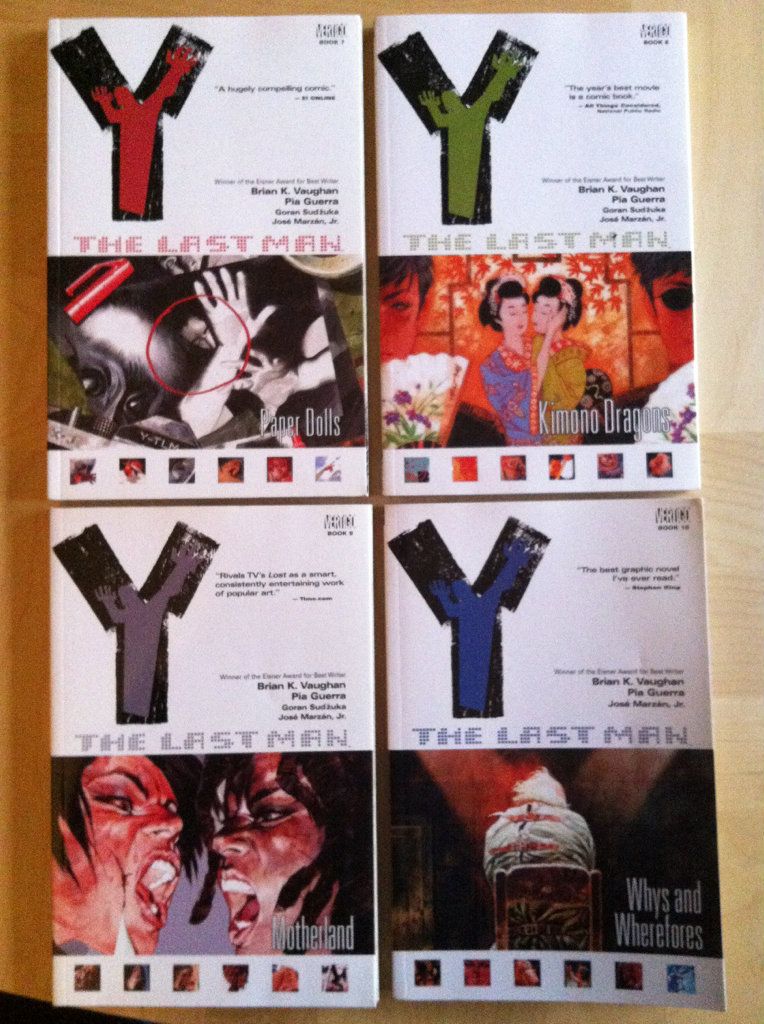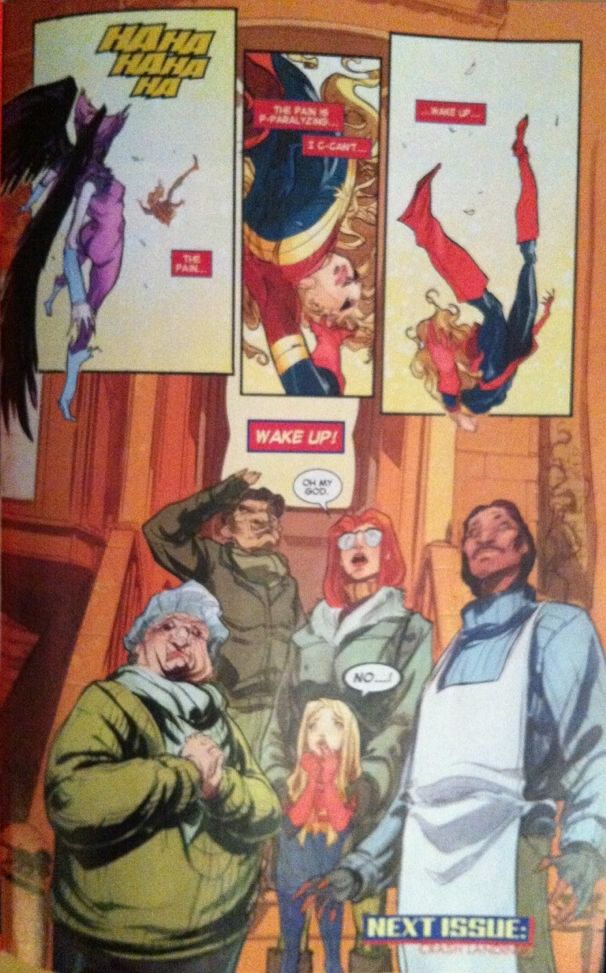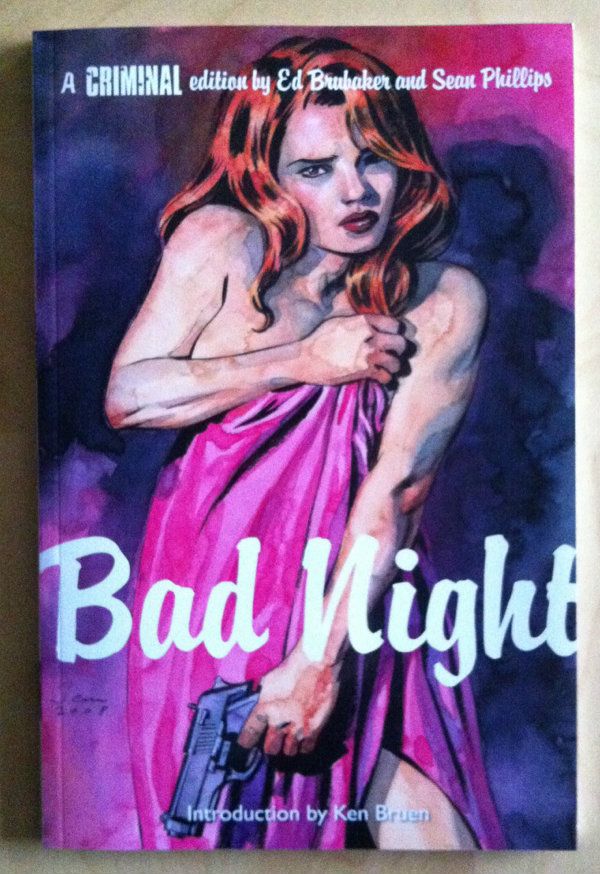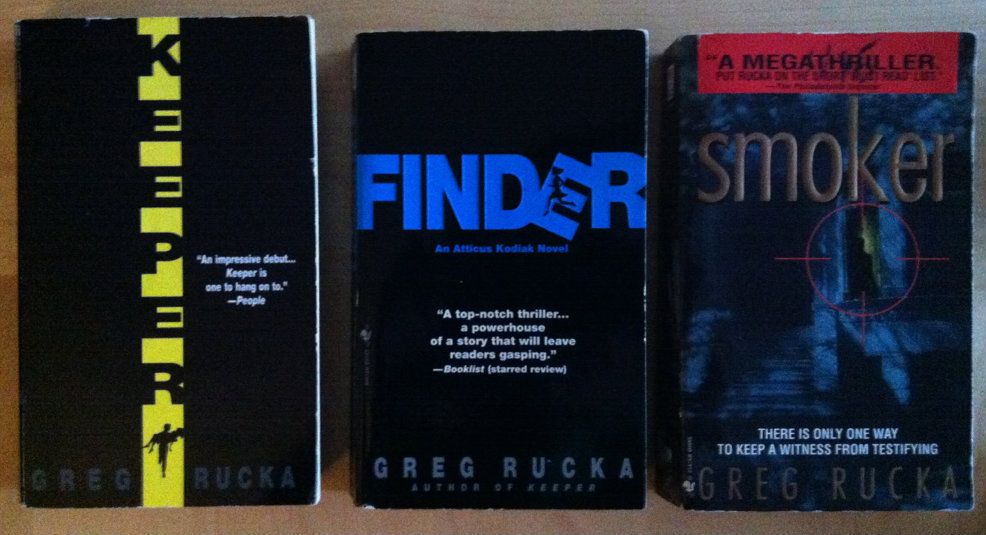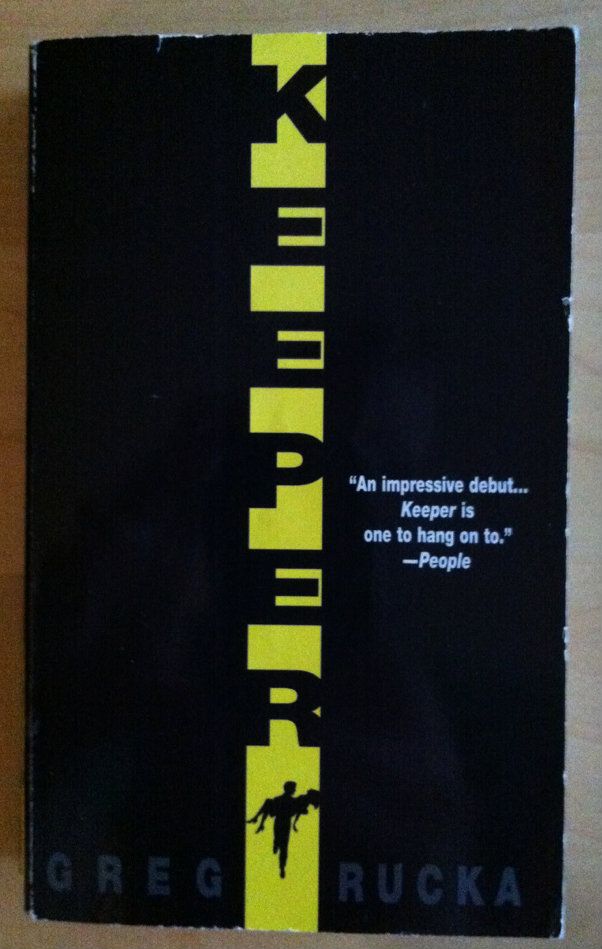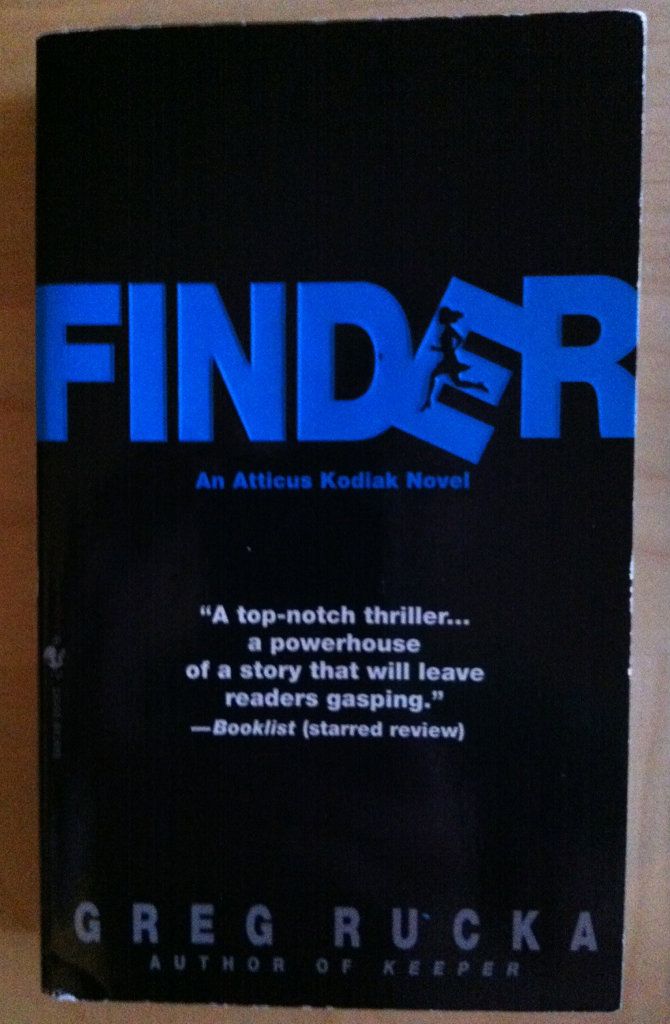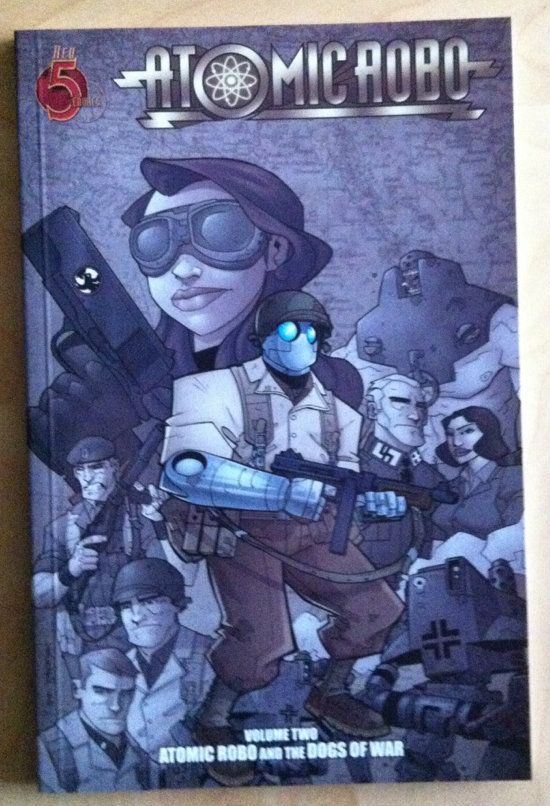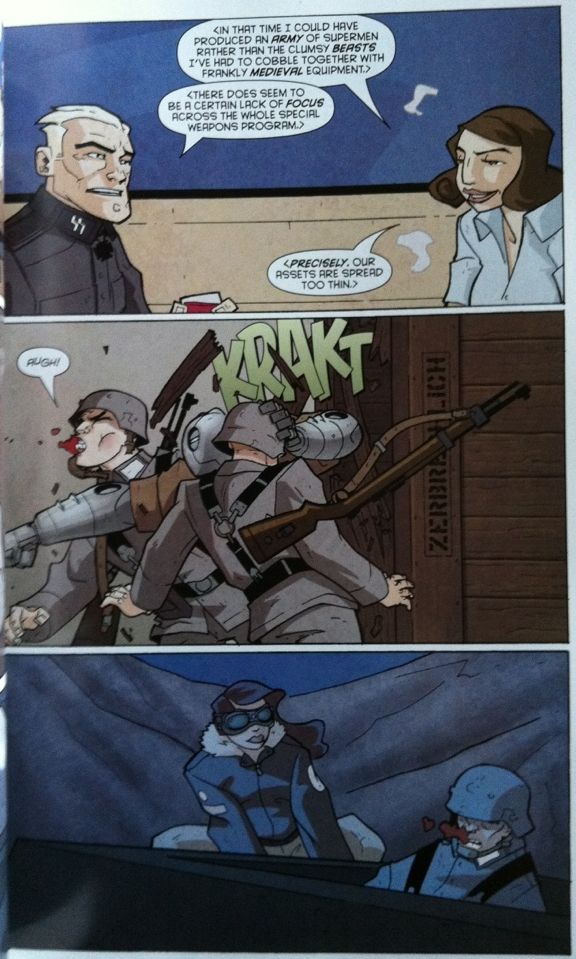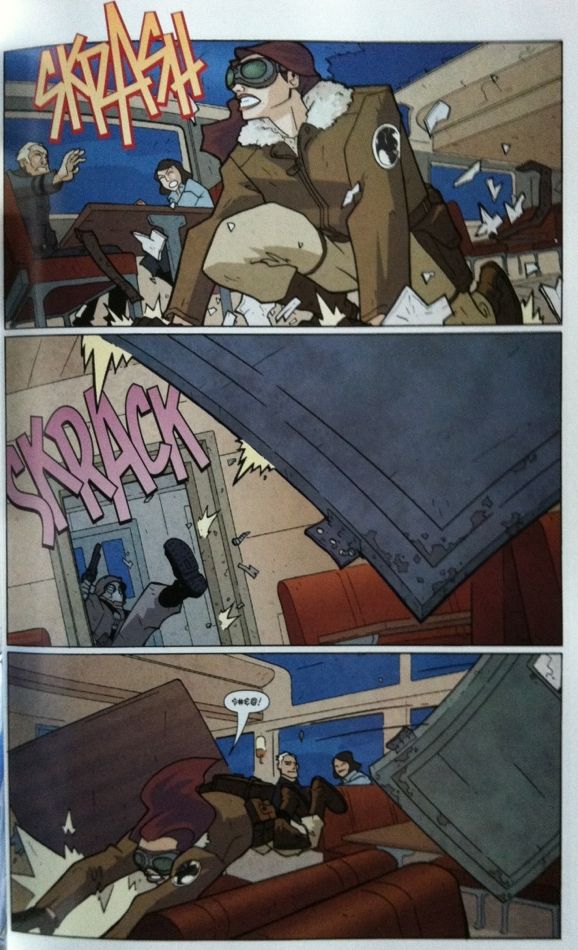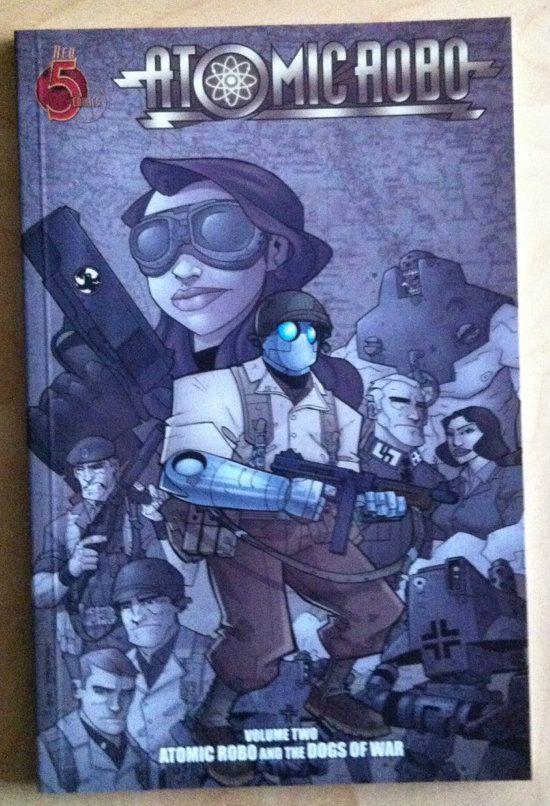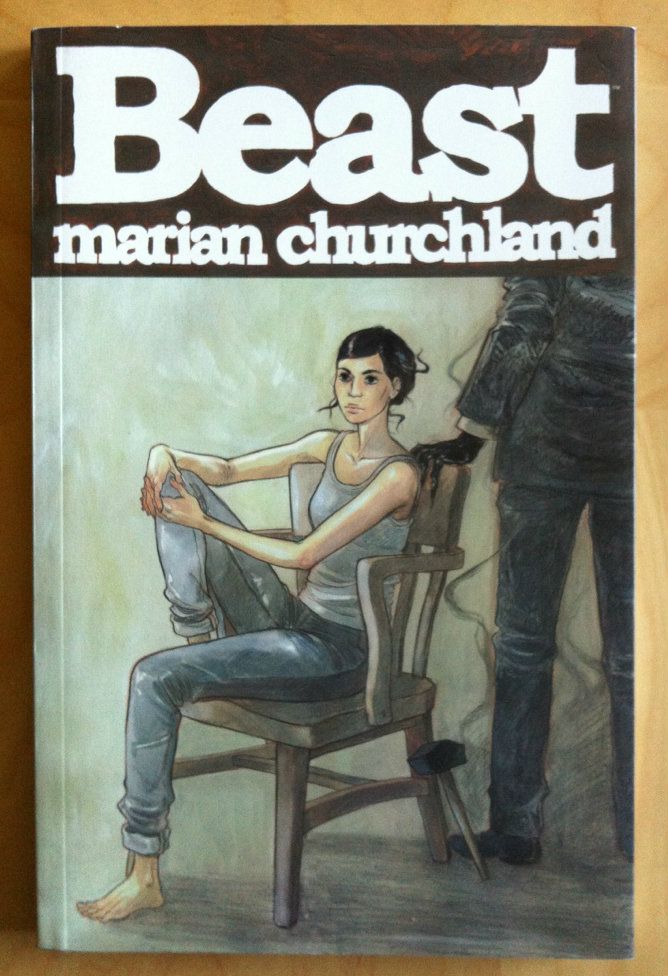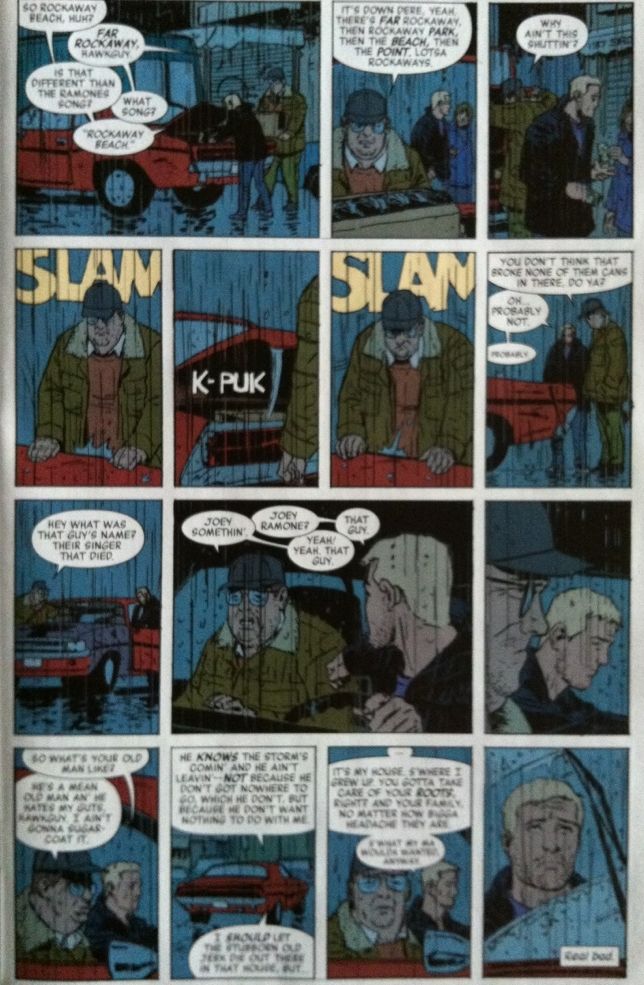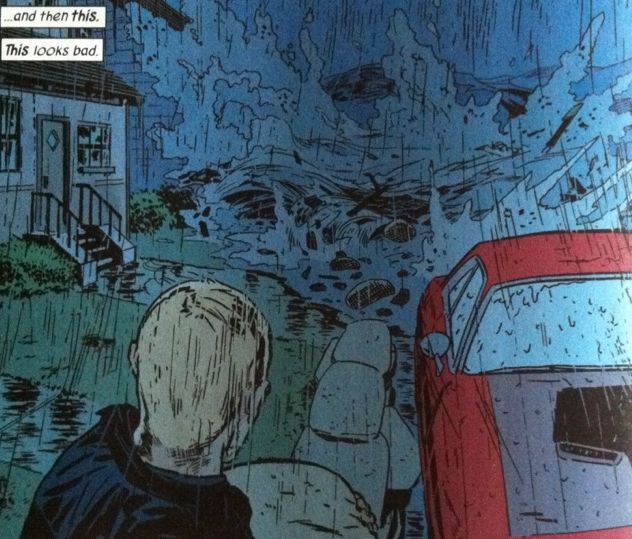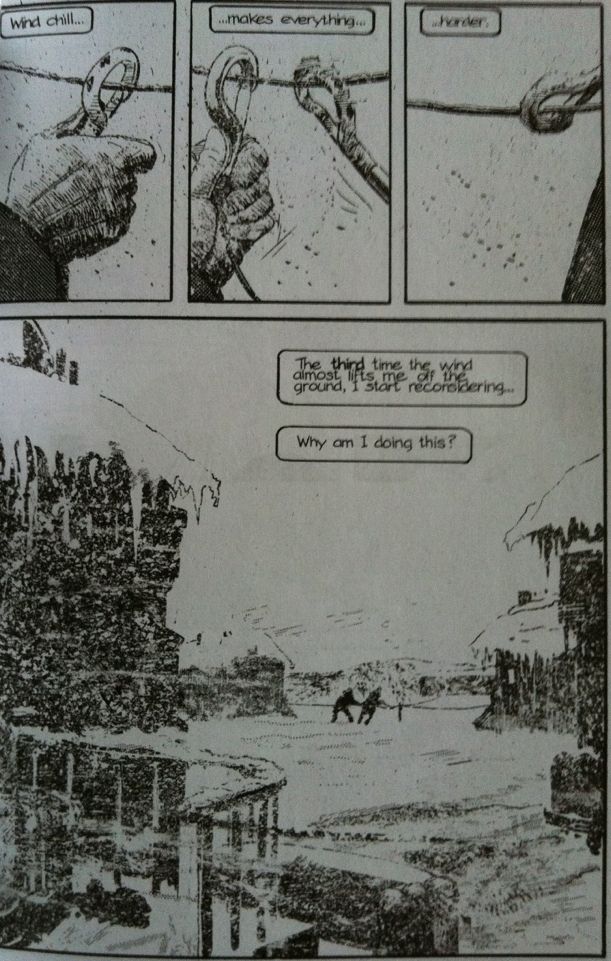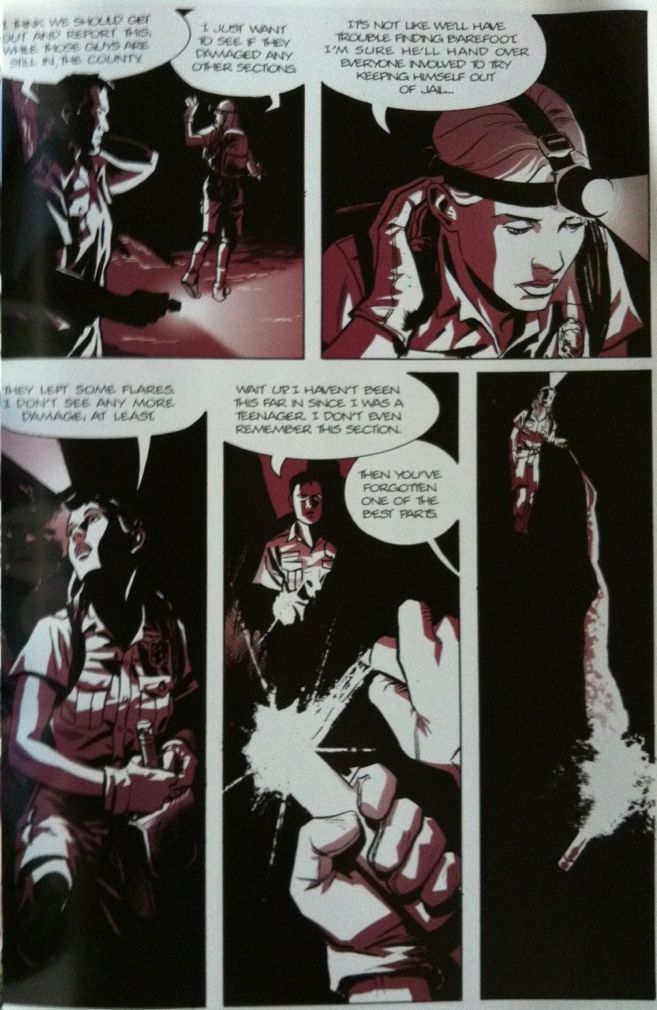A 250 word (or less) review of Y The Last Man the complete series
By Brian K Vaughan and Pia Guerra, Vertigo Comics
In my experience Y The Last Man is essentially universally likeable. The central hook of the comic is
that every male organism on earth suddenly dies with the exception of two
survivors: Yorick, a naive twenty-something, and his pet monkey Ampersand. The
pair is eventually teamed up with Agent 355 and brilliant scientist Dr.
Alison Mann to discover the source of the pair’s immunity and to cure the plague. The book hinges on
the group saving humanity, escaping man-hating Amazons, surviving the predations
of Israeli commandos, and finding Yorick's lost sweetheart, Beth, in a ladies-only
dystopian future. Thematically the book is an extended examination of the
relationship between genders and how they do or don't fit together. For all its
action and suspense, Y is at its core a really insightful book. Brian K Vaughan
is a superb writer who masterfully and seamlessly mixes humour, drama, comedy,
and action to create an eminently readable story. Pia Guerra's art is similarly
brilliant: with a clean, detailed, and expressive style that really enhances
the story. Y The Last Man is also kind of the perfect comic for new readers:
the story is a real page turner with lovable characters and endless cliff
hangers and the artwork is gorgeous and accessible. I have leant this series to
many non-comics readers and they have all enjoyed it and been open to trying
another comic. So even if you aren’t comics people read Y The Last Man. Empirical
data suggests you will not be disappointed.
Wednesday, 27 February 2013
Monday, 25 February 2013
Marvelling at Captain Marvel #10
Or writing about a writer's contract with their readers.
There be *SPOILERS* in this one. So go read Captain Marvel #10 before reading this post.
Captain Marvel #10 is another great comic from the creative team of Kelly Sue DeConnick, Christopher Sebela, and Filipe Andrade. It picks up where #9 left off with the revelation that Carol Danvers has a lesion in her brain that may be catastrophically exacerbated through the use of her powers. As a result, Carol is literally grounded by sound medical advice. Captain Marvel #10, then, is a comic about Carol dealing, or rather failing to deal, with the revelation of her condition. It's a comic about willfully ignoring weakness, pushing past limitations, and the consequences of hubris. It's a comic about falling.
(Captain Marvel #10 is also a super well constructed comic that functions both as an individual story and as a part of an ongoing narrative. It's also beautifully drawn.)
Captain Marvel #10 also does something really effective in how it lays out the story and sets up its themes.
The first page of the comic depicts a dream Carol is having about her love of flying to the edge of the atmosphere, passing out, and free-falling back to Earth. In the dream this is presented as a kind-of-game-of-chicken with gravity where the object of the game is to wake up before she hits the ground. It's a pretty great summary of Carol as a character: she loves to fly, is happiest when using her powers, and is stubborn enough to challenge gravity. This sequence also simultaneously introduces her powers and illustrates that Carol enjoys taking risks. The dream further manages to be a pitch perfect moment following the revelation of the brain lesion in the previous issue: I feel it reveals Carol's fear and establishes flight as something important to her; something that would be very difficult for her to lose. Perhaps most importantly, though, the opening dream sequence beautifully sets up the themes of the comic.
Let me explain. There exists between writers and their audience a... kind of unspoken contract. Readers enter into a manuscript with a certain set of expectations based on all kinds of things: the cover art, the genre, the author's previous work, etc. The author may make further contracts with the audience within the body of the text that also set up additional reader expectations. Something like the brutal murder of The Comedian in the opening pages Alan Moore and Dave Gibbon's Watchman tells the audience that the comic is going to be mature and brutal and that the audience should get ready for an unforgiving read. In a conventional reading sense, the success of the book can be judged by how well the author manages to live up to, or at least address, the contract they establish with their readers.
(That isn't to say satisfying expectations is the only good way to structure a story-some of my favourite reads, like Fraction and Moon's Casanova: Gula, are about subverting or breaking the contract with the reader- but I think nearly all good fiction is at least aware of the contract that has been made and is interacting with it. Besides, this is supposed to be a short essay on CM#10)
The introductory dream sequence in Captain Marvel #10 works beautifully to establish a contract with the reader. It tells us, whether we realize it consciously or not, that this is a comic about flying too high and falling or pushing too hard and suffering the consequences. With this established CM#10 becomes less a reading experience about discovering the next unexpected story development, and more a comic about waiting for the inevitable disaster and dreading the consequences. I think it ratchets up the tension in a really effective way and changes every brash action on the part of Carol Danvers from her-just-being-stubborn into a stepping stone to disaster. It makes every symptom of her brain condition another second clicking off a timer strapped to an explosive that we know will go off. And when Carol inevitably overuses her powers by flying and is sent plummeting back to the ground in a brilliant parallel to the first page dream sequence, it feels EARNED. Which I think is part of why Captain Marvel #10 is such a satisfying reading experience.
So I guess what I'm trying to say is that Captain Marvel #10 is a great comic that, by explicitly stating its intensions early, manages to create palpable tension and a genuinely solid conclusion. I'd go so far as to say that CM#10 is a lesson in how establishing and satisfying a the contract with the reader makes for an especially satisfying read.
Did I mention I really, really like this comic?
Also, this has to be one of the more beautiful single panels in a comic I've seen:
There be *SPOILERS* in this one. So go read Captain Marvel #10 before reading this post.
Captain Marvel #10 is another great comic from the creative team of Kelly Sue DeConnick, Christopher Sebela, and Filipe Andrade. It picks up where #9 left off with the revelation that Carol Danvers has a lesion in her brain that may be catastrophically exacerbated through the use of her powers. As a result, Carol is literally grounded by sound medical advice. Captain Marvel #10, then, is a comic about Carol dealing, or rather failing to deal, with the revelation of her condition. It's a comic about willfully ignoring weakness, pushing past limitations, and the consequences of hubris. It's a comic about falling.
(Captain Marvel #10 is also a super well constructed comic that functions both as an individual story and as a part of an ongoing narrative. It's also beautifully drawn.)
Captain Marvel #10 also does something really effective in how it lays out the story and sets up its themes.
The first page of the comic depicts a dream Carol is having about her love of flying to the edge of the atmosphere, passing out, and free-falling back to Earth. In the dream this is presented as a kind-of-game-of-chicken with gravity where the object of the game is to wake up before she hits the ground. It's a pretty great summary of Carol as a character: she loves to fly, is happiest when using her powers, and is stubborn enough to challenge gravity. This sequence also simultaneously introduces her powers and illustrates that Carol enjoys taking risks. The dream further manages to be a pitch perfect moment following the revelation of the brain lesion in the previous issue: I feel it reveals Carol's fear and establishes flight as something important to her; something that would be very difficult for her to lose. Perhaps most importantly, though, the opening dream sequence beautifully sets up the themes of the comic.
Let me explain. There exists between writers and their audience a... kind of unspoken contract. Readers enter into a manuscript with a certain set of expectations based on all kinds of things: the cover art, the genre, the author's previous work, etc. The author may make further contracts with the audience within the body of the text that also set up additional reader expectations. Something like the brutal murder of The Comedian in the opening pages Alan Moore and Dave Gibbon's Watchman tells the audience that the comic is going to be mature and brutal and that the audience should get ready for an unforgiving read. In a conventional reading sense, the success of the book can be judged by how well the author manages to live up to, or at least address, the contract they establish with their readers.
(That isn't to say satisfying expectations is the only good way to structure a story-some of my favourite reads, like Fraction and Moon's Casanova: Gula, are about subverting or breaking the contract with the reader- but I think nearly all good fiction is at least aware of the contract that has been made and is interacting with it. Besides, this is supposed to be a short essay on CM#10)
The introductory dream sequence in Captain Marvel #10 works beautifully to establish a contract with the reader. It tells us, whether we realize it consciously or not, that this is a comic about flying too high and falling or pushing too hard and suffering the consequences. With this established CM#10 becomes less a reading experience about discovering the next unexpected story development, and more a comic about waiting for the inevitable disaster and dreading the consequences. I think it ratchets up the tension in a really effective way and changes every brash action on the part of Carol Danvers from her-just-being-stubborn into a stepping stone to disaster. It makes every symptom of her brain condition another second clicking off a timer strapped to an explosive that we know will go off. And when Carol inevitably overuses her powers by flying and is sent plummeting back to the ground in a brilliant parallel to the first page dream sequence, it feels EARNED. Which I think is part of why Captain Marvel #10 is such a satisfying reading experience.
So I guess what I'm trying to say is that Captain Marvel #10 is a great comic that, by explicitly stating its intensions early, manages to create palpable tension and a genuinely solid conclusion. I'd go so far as to say that CM#10 is a lesson in how establishing and satisfying a the contract with the reader makes for an especially satisfying read.
Did I mention I really, really like this comic?
Also, this has to be one of the more beautiful single panels in a comic I've seen:
Friday, 22 February 2013
Things I Worry About: Problematic Creators
Or things I would love to have answers to.
I think one of my favourite things about comics is that a lot of creators are super talented people who are also fairly nice. This makes it very easy to enjoy their work and to actively root for their success. But the unfortunate reality is that talent and being a terrible person are not mutually exclusive. Some really great comics and other media have been made by some pretty awful people. And this has me worrying about what a reader's responsibility is in the face of a problematic author.
Given the internet's reaction to Orson Scott Card writing Superman, his work might be a timely and appropriate lens to frame this discussion.
During an anual family summer vacation, when I was something like 12, I read Ender's Game for the first time. It kind of blew me away. I went on to read Speaker for the Dead and Xenocide and Children of The Mind. And I thought, 12 year old me, that Speaker for the Dead and Xenocide were intelligent and profound books about empathy and acceptance and the importance of rational thought. (Even my twelve year old self recognized that Children of the Mind was an unnecessary and pretty crumby book.) Of course, this was before I knew who Orson Scott Card was and what his religious and disgusting political beliefs are. Frankly, this is a time before I really had a stake in any of these debates anyway: my childhood world was pretty small and apolitical. So I quite enjoyed these novels without worrying about larger issues.
As an undergraduate I learned that Orson Scott Card is a devout Mormon, a homophobe, and a pretty disgusting bigot. (Although I didn't know about his activism yet.) Which actually lead to some pretty interesting conversations with my best friend, a queer feminist who loved Ender's Game while growing up, about jerk authors and the good books they make despite themselves. Out of these conversations I decided to revisit Ender's Game, Speaker for the Dead, and Xenocide with an adult viewpoint, some world experience, and some knowledge about Card's affiliations. And I'm conflicted to report that the novels kind of hold up for me. I mean, Speaker for the Dead and Xenocide are not half as clever I thought they were and have some pretty problematic racial themes, some fucking awful Science, and characters who relate to one another in a bizarre and asexual way. But these books, flawed as they are, still have some good ideas and themes. More problematically, perhaps, Ender's Game itself really holds up. Despite everything I know about Orson Scott Card, Ender's Game is a properly good Science Fiction novel. I have no idea how such a hateful, small man who has written so many profoundly underwhelming things managed to extrude a good novel... but I still really like Ender's Game.
Which is problematic, especially given that not only is Orson Scott Card a disgusting and outspoken bigot but also a member of the National Organisation of Marriage, an anti-gay activist group, where he actively lobbies against human and civil rights for homosexual people. Which is a whole other league of deplorable: hateful actions are worse than having hateful opinions (which are awful enough alone). And in this light I really don't know if it's okay to still enjoy Ender's Game.
Of course, good media being made by shit human beings isn't limited to Orson Scott Card. Cerebus, I'm told, is a landmark comic that I would love to buy and read if it ever gets printed again. Unfortunately, its creator, Dave Sim, is a raving misogynist and bonafide crazy person. Frank Millar, who among other things is apparently a racist, has also made a ton of landmark comics, many of which I'm interested in exploring. Tony Harris, the artist of Ex Machina, a Brian K Vaughan written comic I really like, has some really troublesome and unhealthy ideas about women. And the list could probably go on and on.
I guess what my main question is, is it okay to enjoy media from a creator who you fundamentally disagree with? If the work is well made and isn't offensive in and of itself, does it matter what the authors views are? Can the work stand on its own? Or does a loathsome author with deplorable ideas completely invalidate the merits of a work regardless of its quality? I really don't know the answer to this.
In a similar line of questioning, do we as readers have a responsibility to not purchase works by loathsome authors? Does our buying the non-problematic works of an author with deplorable ideas validate those shitty attitudes? Or does our custom just mean that we want to read or like a particular work? Does a jerk author still deserve compensation for their worthwhile products? Is there a distinction between authors that vocally have awful opinions and authors who campaign or act on their deplorable stances? Is, say, buying the work of Orson Scott Card worse than paying to read Dave Sim's Cerebus? Again, I'm not entirely sure what the answer is.
At the end of the day, I think we as readers DO have a responsibility to hold the media we consume and the people who make it to certain standards of human behaviour. I just don't know that there is a clear cut answer for every single situation. And until I have those answers this will be something I worry about.
(I will probably continue to enjoy Ex Machina despite Tony Harris. I will likely one day read Frank Millar's Sin City and Batman work. If Dave Sim can ever play nice with a publisher, I will certainly read Cerebus. While I won't read Orson Scott Card's Superman or any of his new books, I will probably reread Ender's Game again one day. But if I ever need to replace my years old paperback of it, I'll be sure to pick it up at a used bookstore and I will definitely continue to tell anyone who mentions Card about what a jerk he is. )
I think one of my favourite things about comics is that a lot of creators are super talented people who are also fairly nice. This makes it very easy to enjoy their work and to actively root for their success. But the unfortunate reality is that talent and being a terrible person are not mutually exclusive. Some really great comics and other media have been made by some pretty awful people. And this has me worrying about what a reader's responsibility is in the face of a problematic author.
Given the internet's reaction to Orson Scott Card writing Superman, his work might be a timely and appropriate lens to frame this discussion.
During an anual family summer vacation, when I was something like 12, I read Ender's Game for the first time. It kind of blew me away. I went on to read Speaker for the Dead and Xenocide and Children of The Mind. And I thought, 12 year old me, that Speaker for the Dead and Xenocide were intelligent and profound books about empathy and acceptance and the importance of rational thought. (Even my twelve year old self recognized that Children of the Mind was an unnecessary and pretty crumby book.) Of course, this was before I knew who Orson Scott Card was and what his religious and disgusting political beliefs are. Frankly, this is a time before I really had a stake in any of these debates anyway: my childhood world was pretty small and apolitical. So I quite enjoyed these novels without worrying about larger issues.
As an undergraduate I learned that Orson Scott Card is a devout Mormon, a homophobe, and a pretty disgusting bigot. (Although I didn't know about his activism yet.) Which actually lead to some pretty interesting conversations with my best friend, a queer feminist who loved Ender's Game while growing up, about jerk authors and the good books they make despite themselves. Out of these conversations I decided to revisit Ender's Game, Speaker for the Dead, and Xenocide with an adult viewpoint, some world experience, and some knowledge about Card's affiliations. And I'm conflicted to report that the novels kind of hold up for me. I mean, Speaker for the Dead and Xenocide are not half as clever I thought they were and have some pretty problematic racial themes, some fucking awful Science, and characters who relate to one another in a bizarre and asexual way. But these books, flawed as they are, still have some good ideas and themes. More problematically, perhaps, Ender's Game itself really holds up. Despite everything I know about Orson Scott Card, Ender's Game is a properly good Science Fiction novel. I have no idea how such a hateful, small man who has written so many profoundly underwhelming things managed to extrude a good novel... but I still really like Ender's Game.
Which is problematic, especially given that not only is Orson Scott Card a disgusting and outspoken bigot but also a member of the National Organisation of Marriage, an anti-gay activist group, where he actively lobbies against human and civil rights for homosexual people. Which is a whole other league of deplorable: hateful actions are worse than having hateful opinions (which are awful enough alone). And in this light I really don't know if it's okay to still enjoy Ender's Game.
Of course, good media being made by shit human beings isn't limited to Orson Scott Card. Cerebus, I'm told, is a landmark comic that I would love to buy and read if it ever gets printed again. Unfortunately, its creator, Dave Sim, is a raving misogynist and bonafide crazy person. Frank Millar, who among other things is apparently a racist, has also made a ton of landmark comics, many of which I'm interested in exploring. Tony Harris, the artist of Ex Machina, a Brian K Vaughan written comic I really like, has some really troublesome and unhealthy ideas about women. And the list could probably go on and on.
I guess what my main question is, is it okay to enjoy media from a creator who you fundamentally disagree with? If the work is well made and isn't offensive in and of itself, does it matter what the authors views are? Can the work stand on its own? Or does a loathsome author with deplorable ideas completely invalidate the merits of a work regardless of its quality? I really don't know the answer to this.
In a similar line of questioning, do we as readers have a responsibility to not purchase works by loathsome authors? Does our buying the non-problematic works of an author with deplorable ideas validate those shitty attitudes? Or does our custom just mean that we want to read or like a particular work? Does a jerk author still deserve compensation for their worthwhile products? Is there a distinction between authors that vocally have awful opinions and authors who campaign or act on their deplorable stances? Is, say, buying the work of Orson Scott Card worse than paying to read Dave Sim's Cerebus? Again, I'm not entirely sure what the answer is.
At the end of the day, I think we as readers DO have a responsibility to hold the media we consume and the people who make it to certain standards of human behaviour. I just don't know that there is a clear cut answer for every single situation. And until I have those answers this will be something I worry about.
(I will probably continue to enjoy Ex Machina despite Tony Harris. I will likely one day read Frank Millar's Sin City and Batman work. If Dave Sim can ever play nice with a publisher, I will certainly read Cerebus. While I won't read Orson Scott Card's Superman or any of his new books, I will probably reread Ender's Game again one day. But if I ever need to replace my years old paperback of it, I'll be sure to pick it up at a used bookstore and I will definitely continue to tell anyone who mentions Card about what a jerk he is. )
Wednesday, 20 February 2013
So I Read Criminal: Bad Night
A 250 word (or less) review of the fourth Criminal
collection
By Ed Brubaker and Sean Phillips, Icon Comics
I remember reading a book introduction written by Ed Brubaker where he discussed the downward spiral of the protagonist as a formative element of good Crime/Noir fiction. You know, that particular way in which the "hero" of Noir stories are often undercut by events and then pummeled and dragged through the mud before being buried in their hubris, poor judgement, or just plain shitty luck? Well, Criminal: Bad Night has always exemplified this genre trope for me. In Bad Night Jacob Kurtz, a former counterfeiter turned legitimate newspaper cartoonist, is accidentally dragged back into his life of crime. While trying to walk off his insomnia at a local diner Kurtz accidentally gets caught in a domestic dispute between a thug and his ravishing lady friend. Kurtz tries to give the drunken damsel in distress a ride home and... events spiral out of control. Criminal bad night is another excellent book from Brubaker and Phillips which drags you into their booze and blood and sex filled world of violent criminals. The art is incredible, the writing superb, and the world created endlessly fascinating. I love these books, and I suspect you will too.
By Ed Brubaker and Sean Phillips, Icon Comics
I remember reading a book introduction written by Ed Brubaker where he discussed the downward spiral of the protagonist as a formative element of good Crime/Noir fiction. You know, that particular way in which the "hero" of Noir stories are often undercut by events and then pummeled and dragged through the mud before being buried in their hubris, poor judgement, or just plain shitty luck? Well, Criminal: Bad Night has always exemplified this genre trope for me. In Bad Night Jacob Kurtz, a former counterfeiter turned legitimate newspaper cartoonist, is accidentally dragged back into his life of crime. While trying to walk off his insomnia at a local diner Kurtz accidentally gets caught in a domestic dispute between a thug and his ravishing lady friend. Kurtz tries to give the drunken damsel in distress a ride home and... events spiral out of control. Criminal bad night is another excellent book from Brubaker and Phillips which drags you into their booze and blood and sex filled world of violent criminals. The art is incredible, the writing superb, and the world created endlessly fascinating. I love these books, and I suspect you will too.
Word count: 192
Previously:
So I Read Criminal: Coward
So I Read Criminal: Lawless
So I Read Criminal: The Dead and The Dying
So I Read Fatale: Death Chases Me
Monday, 18 February 2013
The Atticus Kodiak Novels Are Good Books
Or why you should read Keeper, Finder, and Smoker by Greg Rucka.
Before he wrote comic books, Greg Rucka wrote a series of prose novels about Atticus Kodiak, a personal security agent. They are, as the thriller genre demands, some exciting, suspenseful novels. They are also a good deal more intelligent and progressive than I was expecting given my previous experiences with Thriller books (which I often find jingoistic and predictable). Rucka's thriller novels are also exceptionally well written in kind of a fascinating way.
Thrillers are designed to be exciting. Functionally this means that the books are punctuated by thrilling action sequences separated by tense, drawn out builds to these action sequences. Kind of like genre literature dub-step: a suspenseful pause before the bass of action drops. But novels can't really just be standoffs and shoot-em-ups; they require character development, stage direction, and key infodumps which add critical context and empathy driven stakes to story outcomes. All of these under the hood story mechanisms are required to make a novel work as emotionally resonate literature.
In his Atticus Kodiak novels Rucka displays an incredible knack for establishing these all important story logistics. From a broad standpoint the Kodiak novels conform to the formula of Thrillers: the novels run on a fuel of fearsomely exciting action sequences and breathe-catching suspense sections. These parts of the novels are great, but I think part of what really makes these books remarkable is the sheer engineered efficiency of the intervening logistics. Rucka, like some kind of old world artisan, seems to effortlessly slot together story elements to simultaneously establish new status quos, reposition characters, and provide plot advancing information all while also developing the characters and the relationships which form the emotional core of his stories. All of this is accomplished with such quiet competence that I frequently lost track of all of this as it happened, the story becoming seamless, until the logistical mechanism completes itself, unexpectedly snaps into motion, and drops the floor out from underneath the current status quo to initiate the next tense build and action sequence. I guess what I'm trying to say is that Rucka's Atticus Kodiak novels are like some kind of elaborate trap which crushes even wary readers in their emotionally resonate Action jaws.
I'm also trying to say that you should read them.
Keeper: I wrote a longer thingy about this book already. So briefly, Keeper sees Atticus Kodiak trying to protect a women's health provider and her daughter from anti-choice extremists in a delightfully progressive and exciting book.
Finder: Atticus Kodiak is tasked with protecting Erika Wyatt, the runaway daughter of his former commanding officer as a gruesome custody battle unfolds between her parents and is complicated by two rival Bricks of SAS comandos. It's twisty as all hell, complicated, and emotionally nasty. I quite enjoyed it.
Smoker: Atticus Kodiak, while down on his bodyguarding luck, gets dragged into protecting a key witness in a Tobacco lawsuit from one of the Ten most deadly assassins in the world. What follows is an elaborate cat and mouse game played out in brutally tense detail. Smoker is an absolute white knuckler of a novel.
Before he wrote comic books, Greg Rucka wrote a series of prose novels about Atticus Kodiak, a personal security agent. They are, as the thriller genre demands, some exciting, suspenseful novels. They are also a good deal more intelligent and progressive than I was expecting given my previous experiences with Thriller books (which I often find jingoistic and predictable). Rucka's thriller novels are also exceptionally well written in kind of a fascinating way.
Thrillers are designed to be exciting. Functionally this means that the books are punctuated by thrilling action sequences separated by tense, drawn out builds to these action sequences. Kind of like genre literature dub-step: a suspenseful pause before the bass of action drops. But novels can't really just be standoffs and shoot-em-ups; they require character development, stage direction, and key infodumps which add critical context and empathy driven stakes to story outcomes. All of these under the hood story mechanisms are required to make a novel work as emotionally resonate literature.
In his Atticus Kodiak novels Rucka displays an incredible knack for establishing these all important story logistics. From a broad standpoint the Kodiak novels conform to the formula of Thrillers: the novels run on a fuel of fearsomely exciting action sequences and breathe-catching suspense sections. These parts of the novels are great, but I think part of what really makes these books remarkable is the sheer engineered efficiency of the intervening logistics. Rucka, like some kind of old world artisan, seems to effortlessly slot together story elements to simultaneously establish new status quos, reposition characters, and provide plot advancing information all while also developing the characters and the relationships which form the emotional core of his stories. All of this is accomplished with such quiet competence that I frequently lost track of all of this as it happened, the story becoming seamless, until the logistical mechanism completes itself, unexpectedly snaps into motion, and drops the floor out from underneath the current status quo to initiate the next tense build and action sequence. I guess what I'm trying to say is that Rucka's Atticus Kodiak novels are like some kind of elaborate trap which crushes even wary readers in their emotionally resonate Action jaws.
I'm also trying to say that you should read them.
Keeper: I wrote a longer thingy about this book already. So briefly, Keeper sees Atticus Kodiak trying to protect a women's health provider and her daughter from anti-choice extremists in a delightfully progressive and exciting book.
Finder: Atticus Kodiak is tasked with protecting Erika Wyatt, the runaway daughter of his former commanding officer as a gruesome custody battle unfolds between her parents and is complicated by two rival Bricks of SAS comandos. It's twisty as all hell, complicated, and emotionally nasty. I quite enjoyed it.
Smoker: Atticus Kodiak, while down on his bodyguarding luck, gets dragged into protecting a key witness in a Tobacco lawsuit from one of the Ten most deadly assassins in the world. What follows is an elaborate cat and mouse game played out in brutally tense detail. Smoker is an absolute white knuckler of a novel.
Friday, 15 February 2013
Deep Sequencing: Atomic Robo And The Dogs Of War
Or a closer look at Atomic Robo And The Dogs Of War
By Brian Clevinger and Scott Wegener, Red 5 Comics
Comics are essentially words and pictures arranged to sequentially convey a story narrative. As such they have a kind of visual language. In North America the sequence of art and events flows from left to right and from top to bottom. Like the words in this blog, but, you know, beautiful pictures that tell a story instead of barely articulate prose.
Typically this visual language manifests as some variation of grid or grid-like layout punctuated by the odd full page image for impact or double page splash for double-impact. This is, in a hugely oversimplified sense, the default storytelling approach. And as such, it's a big comfortable pipeline for narrative information flow for people who are used to sequential art in comics.
The thing is there are some pretty spectacular and interesting things that happen when creators ignore the standard approach and try something else.
Atomic Robo And The Dogs Of War, by Brian Clevinger and Scott Wegener, is a fun adventure comic about a sass mouthed Robot fighting evil Nazi Science during World War II. It's a pleasant comic to look at throughout, but it's especially interesting in chapter 3 which sees Atomic Robo and British agent the Sparrow collide in their attempt to capture evil Nazi Scientists aboard a train.
Mild *SPOILERS* exist beyond this point.
See, rather than use the standard left-to-right top-down grid, Clevinger and Wegener tell the first half of this chapter by breaking the page into thirds that are happening concurrently. That is to say on any given page the top panel occurs at about the same time that the second panel and third panel occur. Each third of the page has its own character focus, and from page to page tells a discrete sequential story that follows the Nazi Scientists, Robo, and Agent Sparrow respectively. It's a fairly simple seeming approach for telling separate simultaneous storylines, but its super effective.
And of course, this all gets even more clever as the three simultaneous, and yet separate story lines, collide with characters and elements from previously isolated narratives barge into the other narratives. It's a really clever and great way to pay off the separated storyline approach before returning to more conventional comic storytelling.
Which I guess is all my way of saying that Clevinger and Wegener are good at comics. I think Atomic Robo is a remarkable comic that manages to be an accessible, all ages friendly adventure comic that also manages to be funny. And I think that, in a way that maybe doesn't get its due, Atomic Robo is remarkable in execution, in both the conventional and unconventional craft the creators display in telling their stories about a sass mouthed Robot fighting Nazis.
By Brian Clevinger and Scott Wegener, Red 5 Comics
Comics are essentially words and pictures arranged to sequentially convey a story narrative. As such they have a kind of visual language. In North America the sequence of art and events flows from left to right and from top to bottom. Like the words in this blog, but, you know, beautiful pictures that tell a story instead of barely articulate prose.
Typically this visual language manifests as some variation of grid or grid-like layout punctuated by the odd full page image for impact or double page splash for double-impact. This is, in a hugely oversimplified sense, the default storytelling approach. And as such, it's a big comfortable pipeline for narrative information flow for people who are used to sequential art in comics.
The thing is there are some pretty spectacular and interesting things that happen when creators ignore the standard approach and try something else.
Atomic Robo And The Dogs Of War, by Brian Clevinger and Scott Wegener, is a fun adventure comic about a sass mouthed Robot fighting evil Nazi Science during World War II. It's a pleasant comic to look at throughout, but it's especially interesting in chapter 3 which sees Atomic Robo and British agent the Sparrow collide in their attempt to capture evil Nazi Scientists aboard a train.
Mild *SPOILERS* exist beyond this point.
See, rather than use the standard left-to-right top-down grid, Clevinger and Wegener tell the first half of this chapter by breaking the page into thirds that are happening concurrently. That is to say on any given page the top panel occurs at about the same time that the second panel and third panel occur. Each third of the page has its own character focus, and from page to page tells a discrete sequential story that follows the Nazi Scientists, Robo, and Agent Sparrow respectively. It's a fairly simple seeming approach for telling separate simultaneous storylines, but its super effective.
And of course, this all gets even more clever as the three simultaneous, and yet separate story lines, collide with characters and elements from previously isolated narratives barge into the other narratives. It's a really clever and great way to pay off the separated storyline approach before returning to more conventional comic storytelling.
Which I guess is all my way of saying that Clevinger and Wegener are good at comics. I think Atomic Robo is a remarkable comic that manages to be an accessible, all ages friendly adventure comic that also manages to be funny. And I think that, in a way that maybe doesn't get its due, Atomic Robo is remarkable in execution, in both the conventional and unconventional craft the creators display in telling their stories about a sass mouthed Robot fighting Nazis.
Wednesday, 13 February 2013
So I Read Atomic Robo and The Dogs Of War
A 250 word (or less) review of the second Atomic Robo
trade paperback
By Brian Clevinger and
Scott Wegener, Red 5 Comics
Atomic Robo is a terrifically fun adventure comic that manages to strike this perfect balance between comicky action and comedy that is just super delightful and fun to read. If you are unfamiliar with the series, the comic tells stories about the adventures of Atomic Robo, the Nicola Tesla invented robot, set in one of the many decades of his life. Atomic Robo and The Dogs Of War focuses exclusively on Robo's involvement in the Second World War fighting evil Nazi scientists and their gruesome super soldiers and Laufpanzer robot tanks. This trade feels very Indianna Jonesy, both in the swashbuckling adventure mixed with comedy sense, but also in the WW2, Nazi fighting setting. It's tremendously fun. Atomic Robo and The Dogs Of War is a much more complete narrative than the first Atomic Robo collected volume, being more thematically and narratively integrated. It's also a pretty young audience friendly book (some dudes get not-so-graphically killed) and is exactly the kind of book a young version of myself would have loved: action packed, funny, and not at all condescending. I’d recommend this book to virtually anyone (of any age) who likes a funny adventure story that won’t insult your intelligence. Also: one of the chapters in the book is a tribute to how awesome Scott Wegeners grandfather is, which is pretty great.
Word count: 222
Previously:
Monday, 11 February 2013
Things I Worry About: Tradewaiting
Or things I would love to know the actual answers to.
The main idea of this blog is that I'm trying to read the best comics I can on a somewhat responsible budget. Part of this is setting a limit on how many magazine format comics I buy a month: I follow 10 and only 10 mainstream (Marvel and DC) comics at a time. The other part of my comics budget plan is to buy 1 tradepaperback/graphic novel a week with a focus on creator-ownederish comics. I think it's a great system because it allows me to maintain a reasonable comics budget, enjoy the communal elements of magazine format comics, and I get to enjoy a huge variety of great comics this way.
Which basically makes me, for creator-ownderish comics, a tradewaiter.
Instead of reading independenterish comics as they are coming out in magazine format, I wait and buy the collected editions when they are released. These collected formats tend to be slightly cheaper in a content/dollar sense which lets me pack in more comics on my budget which is pretty great. But it's also, I think, a better format: a more complete reading experience in a format that looks nice on a bookshelf and can be conveniently shared with friends. As both a comics reader and consumer tradewaiting is great.
Trouble is, I'm concerned that this approach to comics consumption might be contributing to the cancellation of books I really like.
For a lot of independent comics the creators essentially have to pay for the manufacture and printing themselves. With magazine format comics, if they generate sufficient sales to exceed print costs, the creators can recoup those costs to some extent and, you know, buy groceries and pay rent and such. While creators can certainly realize profits from collected editions, these come out only once every five or six months which is a pretty big stretch to wait for paycheques and especially fraught if the creators haven't covered the costs of individual issues. (This is especially hard on pencillers who can only really work on one comic at a time.) In an ideal world independent comics creators would make enough sales off of monthly magazine format sales to live off of which would make royalties on collected editions bonus profits. An unfortunate ramification of my comics buying habit is that the only monthly magazine comics I read have labour paid for by corporations, while the amazing creator-ownederish trade paperbacks I read do not see my custom during their production. I might be leaving the creators who need it most hanging.
And against this there is the kind of inscrutable way publishers determine which comics get made. I mean, I understand the way magazine comics sales are calculated and tracked: comics are solicited to retailers who guesstimate how many of each comic they will sell (they can't return them), and these guesstimates define a comics "sales". From these quais-sales comics publishers decide whether a comic is selling well enough to justify there being made. Of course this is all a model that assumes comics are only sold as magazines in the direct market, which is not the case. Clearly comics publishers and creators factor in digital sales and the sales of collected editions in both the direct and book store markets when deciding which comics are actually marketable. But to what extent and in what ways isn't so clear to me.
Now, when people ask comics creators about this they generally give a polite answer along the lines of "it shouldn't be the consumers responsibility to save a comic" or "however you want to purchase and read a comic is fine". But contrasted with this is the cancellation of frankly amazing comics like Saucer Country and Phonogram just after tradepaperback volumes entered the market. It makes me wonder...
Which all leads to me worrying about how my comics purchasing habits are affecting comics. It would be really great to know how exactly trade sales factor into the publishing viability of creator-ownederish comics. Is there a certain period, a window, when the sale of collected editions can determine the fate of a book? How do these things differ from publisher to publisher? How do the earnings of trade sales compare to magazine sales for creators? Is one significantly more lucrative than the other? Is one more helpful? Or does it not really matter, as long as the comic is actually bought regardless of the format? I'd like to have more information so I know exactly how my consumption habits work and whether it would make a significant difference if I, and other tradewaiters, changed our behaviour.
Now, I'm not necessarily advocating that we all run out and start a save-the-comics crusade. But in this age of sustainable consumption in pretty much every other facet of our lives, I think its reasonable to think about how our media consumption affects the people who make the content we all love. If nothing else, it would be great to have the information needed to make an informed decision.
The main idea of this blog is that I'm trying to read the best comics I can on a somewhat responsible budget. Part of this is setting a limit on how many magazine format comics I buy a month: I follow 10 and only 10 mainstream (Marvel and DC) comics at a time. The other part of my comics budget plan is to buy 1 tradepaperback/graphic novel a week with a focus on creator-ownederish comics. I think it's a great system because it allows me to maintain a reasonable comics budget, enjoy the communal elements of magazine format comics, and I get to enjoy a huge variety of great comics this way.
Which basically makes me, for creator-ownderish comics, a tradewaiter.
Instead of reading independenterish comics as they are coming out in magazine format, I wait and buy the collected editions when they are released. These collected formats tend to be slightly cheaper in a content/dollar sense which lets me pack in more comics on my budget which is pretty great. But it's also, I think, a better format: a more complete reading experience in a format that looks nice on a bookshelf and can be conveniently shared with friends. As both a comics reader and consumer tradewaiting is great.
Trouble is, I'm concerned that this approach to comics consumption might be contributing to the cancellation of books I really like.
For a lot of independent comics the creators essentially have to pay for the manufacture and printing themselves. With magazine format comics, if they generate sufficient sales to exceed print costs, the creators can recoup those costs to some extent and, you know, buy groceries and pay rent and such. While creators can certainly realize profits from collected editions, these come out only once every five or six months which is a pretty big stretch to wait for paycheques and especially fraught if the creators haven't covered the costs of individual issues. (This is especially hard on pencillers who can only really work on one comic at a time.) In an ideal world independent comics creators would make enough sales off of monthly magazine format sales to live off of which would make royalties on collected editions bonus profits. An unfortunate ramification of my comics buying habit is that the only monthly magazine comics I read have labour paid for by corporations, while the amazing creator-ownederish trade paperbacks I read do not see my custom during their production. I might be leaving the creators who need it most hanging.
And against this there is the kind of inscrutable way publishers determine which comics get made. I mean, I understand the way magazine comics sales are calculated and tracked: comics are solicited to retailers who guesstimate how many of each comic they will sell (they can't return them), and these guesstimates define a comics "sales". From these quais-sales comics publishers decide whether a comic is selling well enough to justify there being made. Of course this is all a model that assumes comics are only sold as magazines in the direct market, which is not the case. Clearly comics publishers and creators factor in digital sales and the sales of collected editions in both the direct and book store markets when deciding which comics are actually marketable. But to what extent and in what ways isn't so clear to me.
Now, when people ask comics creators about this they generally give a polite answer along the lines of "it shouldn't be the consumers responsibility to save a comic" or "however you want to purchase and read a comic is fine". But contrasted with this is the cancellation of frankly amazing comics like Saucer Country and Phonogram just after tradepaperback volumes entered the market. It makes me wonder...
Which all leads to me worrying about how my comics purchasing habits are affecting comics. It would be really great to know how exactly trade sales factor into the publishing viability of creator-ownederish comics. Is there a certain period, a window, when the sale of collected editions can determine the fate of a book? How do these things differ from publisher to publisher? How do the earnings of trade sales compare to magazine sales for creators? Is one significantly more lucrative than the other? Is one more helpful? Or does it not really matter, as long as the comic is actually bought regardless of the format? I'd like to have more information so I know exactly how my consumption habits work and whether it would make a significant difference if I, and other tradewaiters, changed our behaviour.
Now, I'm not necessarily advocating that we all run out and start a save-the-comics crusade. But in this age of sustainable consumption in pretty much every other facet of our lives, I think its reasonable to think about how our media consumption affects the people who make the content we all love. If nothing else, it would be great to have the information needed to make an informed decision.
Friday, 8 February 2013
Soon I Will Be Invincible Is A Good Book
Or why you should read Soon I Will Be Invincible by Austin Grossman
I infrequently go to big chain bookstores because they disappoint me. However, the last time I went to a well curated one they had an end display of serious(ish) superhero novels since apparently that is a novel genre now. So it would appear that with the mainstream appeal of all things supeheroic there is a demand for cape prose novels.
Soon I Will Be Invincible, published in 2007, predates this mainstream popularity and was totally out there before it was cool to be. Man.
It's also a really, really fun book.
Half of Soon I Will Be Invincible is narrated by Dr. Impossible, a super power enhanced genius suffering from Malign Hypercognition Disorder. Dr. Impossible is brilliant. He is evil. He is jaded. He wants to be respected and feared. He is kind of pathetic and really sort of adorable. He has hatched failed plans to take over the world involving doomsday devices, mind-control, time travel, robot armes and alien invasions. But in Soon I Will Be Invincible his ultimate plan will be revealed. He is, simply put, the pompous villain we all love to root for.
The other half of Soon I Will Be Invincible follows cyborg enforcer Fatale: an amnesiac everyday person thrust into the world of super heroics by a runaway truck. In soon I Will Be Invincible she is recruited to join The New Champions, an ersatz Justice League of Earth's mightiest heroes. As such she provides an outsider/everymans perspective of the superheroes of the story. She is drole, she is unsure of herself, she is a very likable character.
To a certain extent Soon I Will Be Invincible functions as both a satire and celebration of the superhero genre. For those who know what's going on the book provides an in depth analysis and history of the superhero genre with many characters standing in for established heroes of the gold, silver, and modern ages of comics. The novel is also hilarious and deconstructionist: it plays with the goofiness of the concept and adds a selective element of comedic realism to the proceedings. The result is a novel with a thinky, celebratory element for the serious comics fan and a hilarious comedic element that should appeal to everyone.
So, honestly, no matter who you are, if you want a fun, casual book about superheroes you should give Soon I Will Be Invincible a shot.
I infrequently go to big chain bookstores because they disappoint me. However, the last time I went to a well curated one they had an end display of serious(ish) superhero novels since apparently that is a novel genre now. So it would appear that with the mainstream appeal of all things supeheroic there is a demand for cape prose novels.
Soon I Will Be Invincible, published in 2007, predates this mainstream popularity and was totally out there before it was cool to be. Man.
It's also a really, really fun book.
Half of Soon I Will Be Invincible is narrated by Dr. Impossible, a super power enhanced genius suffering from Malign Hypercognition Disorder. Dr. Impossible is brilliant. He is evil. He is jaded. He wants to be respected and feared. He is kind of pathetic and really sort of adorable. He has hatched failed plans to take over the world involving doomsday devices, mind-control, time travel, robot armes and alien invasions. But in Soon I Will Be Invincible his ultimate plan will be revealed. He is, simply put, the pompous villain we all love to root for.
The other half of Soon I Will Be Invincible follows cyborg enforcer Fatale: an amnesiac everyday person thrust into the world of super heroics by a runaway truck. In soon I Will Be Invincible she is recruited to join The New Champions, an ersatz Justice League of Earth's mightiest heroes. As such she provides an outsider/everymans perspective of the superheroes of the story. She is drole, she is unsure of herself, she is a very likable character.
To a certain extent Soon I Will Be Invincible functions as both a satire and celebration of the superhero genre. For those who know what's going on the book provides an in depth analysis and history of the superhero genre with many characters standing in for established heroes of the gold, silver, and modern ages of comics. The novel is also hilarious and deconstructionist: it plays with the goofiness of the concept and adds a selective element of comedic realism to the proceedings. The result is a novel with a thinky, celebratory element for the serious comics fan and a hilarious comedic element that should appeal to everyone.
So, honestly, no matter who you are, if you want a fun, casual book about superheroes you should give Soon I Will Be Invincible a shot.
Wednesday, 6 February 2013
So I Read Beast
A 250 word (or less) review of the Beast graphic
novel
By Marian Churchland, Image Comics
By Marian Churchland, Image Comics
Beast is a really good comic in a way that is different from most other comics I've read. The book tells the story of a young sculptor, Colette, who takes a too-good-to-be-true commission for the enigmatic and inhuman Beast. It's an emotionally taut and furiously focused story about creativity and obsession and the way our passions can take over our lives. As someone who gets way too caught up in his hobbies and career sometimes, this aspect of the story really resonates with me. It’s a great story told with intense empathy and a kind of beautiful simplicity. Churchland's artwork is.... I want to call it very "illustrated", in the kind of traditional drawing sense instead of a more modern digital cartooning or super-photo-realism sense. The artwork in this book is sumptuous and unique and more like something you'd see in an art exhibit or antique book than a mainstream comic and this really benefits Beast’s unique voice. The art is also pretty great in that it clearly draws inspiration from locations in my home city of Vancouver: the off the beaten track, non-touristy parts; which is pretty cool. The super personal focus of the book and the beautiful but atypical art just gives Beast a unique and interesting voice. Read it and maybe it will speak to you. It certainly spoke to me.
Word count: 222
Monday, 4 February 2013
Eye on Hawkeye #7
Or my apparently regular feature gushing about Matt Fraction, Steve Lieber, and Jesse Hamm's Hawkeye because this book is perfect.
Wherein I continue my wonky analysis of how great Hawkeye is and say nice things about the creators. All of the standard gushing applies: effortless seeming writing, amazing colours from Matt Hollingsworth, and a high frequency of laugh out loud moments. This time I'm actually going to use this space as an excuse to write something about Steve Lieber and storytelling that I've been thinking about for a while. Specifically that under the art-stick of Steve Lieber setting and environment become full characters in a story.
(Also, how cool is Matt Fraction for donating his incentive payments from this issue to the Red Cross? How effective is it that Fraction chose to tell a story that highlights how godawful the storm itself was and ALSO a story that showcases the challenges faced by survivors? Fucking hell this book is brilliant.)
You should assume that there will be *SPOILERS* within.
From what little I understand about narrative theory, conflict can be broken down into three categories: man-vs-man, man-vs-self, and man-vs-nature. Superhero comic books tend to be heavy on the man-vs-man: Spiderman fights The Green Goblin, Batman fights the Joker and, in Hawkeye #7 Grills is in conflict with his Father about the disposition of his dead mother's effects. The best Cape comics also usually feature some amount of man-vs-self, like Iron Man's trying to stay ahead of his weaknesses and substance abuse issues or Batman trying to stick to his moral code despite the excesses of his adversaries. In Hawkeye #7 we see Grills have an internal conflict between how much he loves his parents and how frustrated and angry his father's actions make him which was a nicely personal and nuanced story beat in a disaster comic. What's remarkable about Hawkeye #7 is that we also see man-vs-nature in the Hawkeyes trying to help people in the chaos of Frankenstorm Sandy. This is something we almost never see in mainstream comics.
Steve Lieber draws the during-the-hurricane half of the comic that follows Hawkguy as he travels to Far Rockaway with his neighbour Grills to help his father get ready for the storm. Sandy arrives, things get wild and wet and windy, and our hero gets to be great at boats. And this all works because Steve Lieber and Matt Hollingsworth build Sandy into nearly every panel which gives it a looming, constant presence before unleashing it to directly imperil our protagonists. Which, in turn, makes the setting function as an actual character in the story.
Steve Lieber has a long history of drawing incredible stories that pit people against the forces of weather. In Whiteout, a crime/thriller written by Greg Rucka about crime in Antarctica, Steve Lieber creates this perfectly realized representation of the frozen continent. Rucka writes a great script that pits the continent's single US Marshal against would be ne'er-do-wells, but its the artwork of Lieber that establishes the frozen world of the Antarctic as the real antagonist, the true challenge that the protagonist and antagonists must overcome. The comic would not work without his steller depiction of the comics' environment. Whiteout is another set of great comics where Lieber is able to establish setting/environment as a distinct character.
But Steve Lieber's man-vs-nature repertoire isn't limited to drawing extreme weather. In Underground, written by Jeff Parker, Lieber and colourist Ron Chan depict the Stillwater cave system as both the setting and key character of the comic. The plot of Underground is kind of like an 80s-90s action movie that pits the story's heroes, a pair of park rangers, against the criminal henchmen of a local business leader with greedy and unlawful plans. Accidents happen and soon the protagonists have to escape the thugs and survive the dangers of the cave system. Lieber and Chan depict a dark, claustrophobic world that captures both the terror and wonder of caves and this is the source of Underground's critical atmosphere. Underground is another comic that works purely because the art team nails setting and environment so effectively. Underground is also a comic where setting becomes a key character in the story.
So here are three amazing comics that, through Steve Lieber's particular attention to environmental details, provide amazing stories that feature man-vs-nature conflicts. To me there are two salient points in this. The first is that Steve Lieber is an incredible artist and that anyone writing a man-vs-nature story would do very well to have him on art duties. The second is that these comics highlight just how fundamental and critically important thorough, well designed environments are to storytelling. A well established and designed setting can elevate a good comic to a great comic and even add a whole other dimension to the storytelling.
I guess what I'm trying to say is that Hawkeye is great at boats and Steve Lieber, he is great at man-vs-nature storytelling.
Wherein I continue my wonky analysis of how great Hawkeye is and say nice things about the creators. All of the standard gushing applies: effortless seeming writing, amazing colours from Matt Hollingsworth, and a high frequency of laugh out loud moments. This time I'm actually going to use this space as an excuse to write something about Steve Lieber and storytelling that I've been thinking about for a while. Specifically that under the art-stick of Steve Lieber setting and environment become full characters in a story.
(Also, how cool is Matt Fraction for donating his incentive payments from this issue to the Red Cross? How effective is it that Fraction chose to tell a story that highlights how godawful the storm itself was and ALSO a story that showcases the challenges faced by survivors? Fucking hell this book is brilliant.)
You should assume that there will be *SPOILERS* within.
From what little I understand about narrative theory, conflict can be broken down into three categories: man-vs-man, man-vs-self, and man-vs-nature. Superhero comic books tend to be heavy on the man-vs-man: Spiderman fights The Green Goblin, Batman fights the Joker and, in Hawkeye #7 Grills is in conflict with his Father about the disposition of his dead mother's effects. The best Cape comics also usually feature some amount of man-vs-self, like Iron Man's trying to stay ahead of his weaknesses and substance abuse issues or Batman trying to stick to his moral code despite the excesses of his adversaries. In Hawkeye #7 we see Grills have an internal conflict between how much he loves his parents and how frustrated and angry his father's actions make him which was a nicely personal and nuanced story beat in a disaster comic. What's remarkable about Hawkeye #7 is that we also see man-vs-nature in the Hawkeyes trying to help people in the chaos of Frankenstorm Sandy. This is something we almost never see in mainstream comics.
Steve Lieber draws the during-the-hurricane half of the comic that follows Hawkguy as he travels to Far Rockaway with his neighbour Grills to help his father get ready for the storm. Sandy arrives, things get wild and wet and windy, and our hero gets to be great at boats. And this all works because Steve Lieber and Matt Hollingsworth build Sandy into nearly every panel which gives it a looming, constant presence before unleashing it to directly imperil our protagonists. Which, in turn, makes the setting function as an actual character in the story.
Steve Lieber has a long history of drawing incredible stories that pit people against the forces of weather. In Whiteout, a crime/thriller written by Greg Rucka about crime in Antarctica, Steve Lieber creates this perfectly realized representation of the frozen continent. Rucka writes a great script that pits the continent's single US Marshal against would be ne'er-do-wells, but its the artwork of Lieber that establishes the frozen world of the Antarctic as the real antagonist, the true challenge that the protagonist and antagonists must overcome. The comic would not work without his steller depiction of the comics' environment. Whiteout is another set of great comics where Lieber is able to establish setting/environment as a distinct character.
But Steve Lieber's man-vs-nature repertoire isn't limited to drawing extreme weather. In Underground, written by Jeff Parker, Lieber and colourist Ron Chan depict the Stillwater cave system as both the setting and key character of the comic. The plot of Underground is kind of like an 80s-90s action movie that pits the story's heroes, a pair of park rangers, against the criminal henchmen of a local business leader with greedy and unlawful plans. Accidents happen and soon the protagonists have to escape the thugs and survive the dangers of the cave system. Lieber and Chan depict a dark, claustrophobic world that captures both the terror and wonder of caves and this is the source of Underground's critical atmosphere. Underground is another comic that works purely because the art team nails setting and environment so effectively. Underground is also a comic where setting becomes a key character in the story.
So here are three amazing comics that, through Steve Lieber's particular attention to environmental details, provide amazing stories that feature man-vs-nature conflicts. To me there are two salient points in this. The first is that Steve Lieber is an incredible artist and that anyone writing a man-vs-nature story would do very well to have him on art duties. The second is that these comics highlight just how fundamental and critically important thorough, well designed environments are to storytelling. A well established and designed setting can elevate a good comic to a great comic and even add a whole other dimension to the storytelling.
I guess what I'm trying to say is that Hawkeye is great at boats and Steve Lieber, he is great at man-vs-nature storytelling.
Friday, 1 February 2013
Phonogram Avengers
Or how Young Avengers reminds makes me think of Phonogram: The Singles Club
Young Avengers is a comic about a group of young superheroes on the cusp of adulthood. Phonogram: The Singles Club tells a story about music as magic and focuses on a group of young Phonomancers (music-wizards) on the cusp of adulthood. Both comics are written by Kieron Gillen, drawn by Jaimie McKelvie, and coloured by Matt Wilson. They are both pretty great comics.
But I think the similarity between the two runs deeper than a common level of quality and shared creators. There is a thematic link about what it is to be on the cusp of adulthood and a similar sensibility about how to convey these ideas that unites both these titles and which at times borders on the uncanny. Now, clearly there are dramatic differences between the two: one features caped heroes and punching and the other a blizzard of pop music references and dancing but the two clearly share a common thread of DNA. I kind of want to compare it to brocoli and cauliflower, how they share a distinct genetic background, a common ancestor from which both modern vegetables are derived. And I think, if you squint a bit at Young Avengers and The Singles Club, the similarities and the evidence of this common thematic ancestor becomes apparent. Like to the point where certain moments, stripped of their Superheroics or music, are virtually indistinguishable.
To that end, I've put together the following test. I've cropped out panels from Young Avengers #1 and Phonogram: The Singles Club to illustrate the uncanny similarity between the two.
1: If you are unfamiliar and haven't read either book, then I challenge you to guess which title each panel is from.
2: If you have read both books and can tell which book each is from based on remembering the panel or recognizing the characters depicted, then I challenge you to look past that and see if you can see the commonalities, the thematic relationship between the two comics.
(Obviously I chose panels that lacked Superheroics and musical references, because those are dead give aways.)
Uncannily similar right? Or am I crazy?
Anyway, I see the common DNA between the two titles and I LOVE it. Phonogram was a brilliant comic, and a mainstream Superhero comic that looks and feels like it is absolutely something that I want and so, I say to you, that Young Avengers is the next best thing to having new Phonogram and that you should all be reading it.
Young Avengers is a comic about a group of young superheroes on the cusp of adulthood. Phonogram: The Singles Club tells a story about music as magic and focuses on a group of young Phonomancers (music-wizards) on the cusp of adulthood. Both comics are written by Kieron Gillen, drawn by Jaimie McKelvie, and coloured by Matt Wilson. They are both pretty great comics.
But I think the similarity between the two runs deeper than a common level of quality and shared creators. There is a thematic link about what it is to be on the cusp of adulthood and a similar sensibility about how to convey these ideas that unites both these titles and which at times borders on the uncanny. Now, clearly there are dramatic differences between the two: one features caped heroes and punching and the other a blizzard of pop music references and dancing but the two clearly share a common thread of DNA. I kind of want to compare it to brocoli and cauliflower, how they share a distinct genetic background, a common ancestor from which both modern vegetables are derived. And I think, if you squint a bit at Young Avengers and The Singles Club, the similarities and the evidence of this common thematic ancestor becomes apparent. Like to the point where certain moments, stripped of their Superheroics or music, are virtually indistinguishable.
To that end, I've put together the following test. I've cropped out panels from Young Avengers #1 and Phonogram: The Singles Club to illustrate the uncanny similarity between the two.
1: If you are unfamiliar and haven't read either book, then I challenge you to guess which title each panel is from.
2: If you have read both books and can tell which book each is from based on remembering the panel or recognizing the characters depicted, then I challenge you to look past that and see if you can see the commonalities, the thematic relationship between the two comics.
(Obviously I chose panels that lacked Superheroics and musical references, because those are dead give aways.)
Uncannily similar right? Or am I crazy?
Anyway, I see the common DNA between the two titles and I LOVE it. Phonogram was a brilliant comic, and a mainstream Superhero comic that looks and feels like it is absolutely something that I want and so, I say to you, that Young Avengers is the next best thing to having new Phonogram and that you should all be reading it.
Subscribe to:
Posts (Atom)

